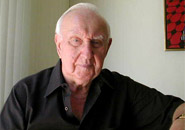 Benjamin Lees died of heart failure on Monday, May 31 at North Shore Long Island Jewish Hospital in Glen Cove, New York at the age of 86.
Benjamin Lees died of heart failure on Monday, May 31 at North Shore Long Island Jewish Hospital in Glen Cove, New York at the age of 86.
Lees’s work rose to prominence in 1954 when the NBC Orchestra performed his Profile for Orchestra in a national broadcast. He was later awarded Guggenheim and Fulbright fellowships, allowing him to live in Europe for seven years and present his works throughout the continent. Upon his return to the United States in 1962, Lees was appointed Professor of Composition at the Peabody Institute in Baltimore, where he served until 1964. He later taught at both the Manhattan School of Music and the Juilliard School of Music. In 1972, Lees was commissioned by the Philadelphia Orchestra to write the music to the text of E.B. White’s “The Trumpet of the Swans.” In 1985, Lees was commissioned by the Dallas Symphony Orchestra to write a piece that would commemorate the 40th anniversary of the end of the Holocaust, Symphony No. 4 ‘Memorial Candles’. Symphony No. 5, commemorating the arrival of Swedish immigrants to Delaware in the 17th century, was recorded, along with his Symphony No. 2 and Symphony No. 3, for Albany Records and earned him a 2004 GRAMMY nomination. A recording of his Violin Concerto by Elmar Oliveira on Artek Records was nominated for a GRAMMY in 2009. His music has been performed around the world over the years at venues such as Lincoln Center in New York, the Kennedy Center in Washington D.C., and in Monaco at a performance celebrating the 500th anniversary of the kingdom. In 2009 Naxos Records released a new recording of his String Quartets Nos. 1, 5 and 6, performed by the Cypress String Quartet.
Benjamin Lees was born January 8, 1924 in Harbin, Manchuria to Russian parents. He and his family immigrated to San Francisco the following year, then moved to Los Angeles in 1939. At age 15, Lees began studying piano harmony and theory, and began composing with his teacher, Marguerite Bitter. After serving in the army during World War II, Lees entered the University of Southern California in Los Angeles in 1945. Lees continued his composition studies with George Antheil until 1954.
When asked about his approach to composition, he was quoted as saying, “There are two kinds of composers. One is the intellectual and the other is visceral. I fall into the latter category. If my stomach doesn’t tighten at an idea, then it’s not the right idea.”
Lees was commissioned to write pieces through his early 80’s and continued writing until his recent death. He is survived by his daughter, Jan Rexon, and his wife, Leatrice Lees.

It was a privilege and a journey to have known Benjamin Lees for almost twenty years. In 1991, Arabesque Records contacted me in regard to recording Mr. Lees’s Sonatas for violin and piano. This recording, with Joel Wizansky, and adding Invenzione for solo violin, was released in 1994 by Albany Records, Arabesque having shut down temporarily.
Mr. Lees created a passageway for me to the worlds that were already significant to me, of Surrealist art and European post WW II avant-garde. It was most amazing to discover that we shared a love for one particular painter, Yves Tanguy. His stories about Marcel Duchamp and Man Ray, whom he and Mrs. Lees knew well, are for the most part not fit to print in public.
It was an especial privilege to put a little black mustache on the title of my Albany CD, Complete Violin Works of Benjamin Lees, by commissioning Landscape – after Yves Tanguy for solo violin in 2004, and premiering it in 2005 at the Maryland Institute College of Art.
Mr. Lees knew exactly how to write for the violin most naturally, and after our collaboration on the recording, he knew so perfectly how to write for my sound. Performing it was the closest I have come to being inside a painting. It was the last performance for me as a soloist, due to health issues, and I cherish the fact that Mr. Lees and I brought Landscape into existence. I will miss him.
On NewMusicBox, we just posted a very moving memorial to Ben by the members of the Cypress Quartet who are in the process of recording his complete string quartets for Naxos American Classics (Volume 1, featuring Nos. 1, 5, and 6 was released last year):
http://www.newmusicbox.org/article.nmbx?id=6416